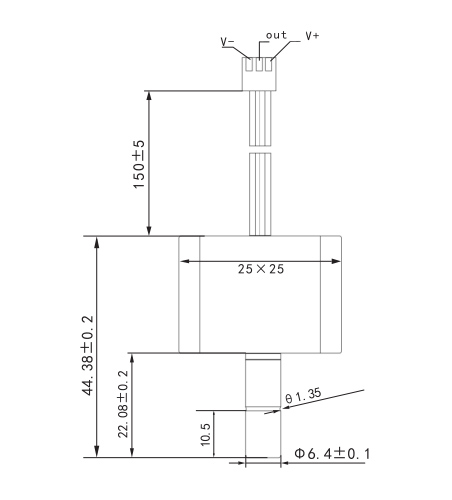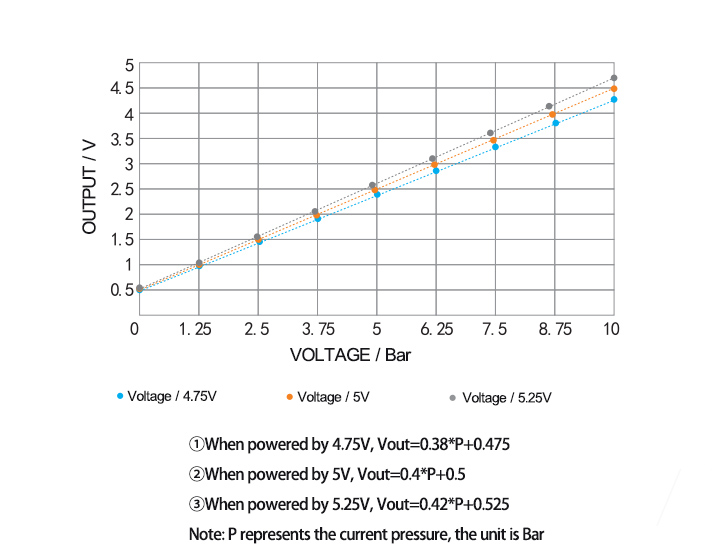LEFOO LFT221 water pressure transmitter adopts plastic shell structure, high-precision pressure core, and proportional output voltage signal. This water pipe pressure sensor is mainly used in the water treatment industry and has the characteristics of small size, light weight, compact structure and good stability.
Lefoo Small Size Water Pressure Sensor LFT221 Features:
* Adopt high-precision ceramic core with good performance
* Small, beautiful product for quick installation
* Compact structure with good stability
Transmitter
| LEFOO Small Size Water Pressure Transmitter LFT221 | ||||
| Measurement Range | 0~1MPa (Normal pressure section) | |||
| Overload pressure | 2 times full scale | |||
| Burst Pressure | 3 times full scale | |||
| Accuracy | ±2.0%F.S. | |||
| Output Mode | Voltage type(Three-wired) | |||
| Power Supply | 4.75-5.25VDC | |||
| Output Signal | 0.5~4.5V | |||
| Working temperature | 0℃~60℃ | |||
| Storage Temperature | -20℃~+85℃ | |||
| Medium Compatibility | Various fluids without corrosion to PA66, ceramics, EPDM | |||
| Load Resistance | ≥14.5KΩ | |||
| Electrical Connection | 3-core 2.54mm spacing wiring terminal | |||
| Protection | IP65 | |||
| Pressure connection | 1/4 PE pipe quick connector | |||


Adopt high-precision ceramic core with good performance
Small, beautiful product for quick installation
Compact structure with good stability
Water treatment industries, Industrial wastewater processing
The first common use for water pressure sensors is for liquid level monitoring, using a transducer at the bottom of a tank. The liquid height above the water pipe pressure sensor produces a pressure, compared to the ambient atmospheric pressure on the 'dry' or 'reference' side of the sensor. As long as the density of the liquid is known, this pressure can be used to compute the liquid level in the tank.
The water pressure sensors are frequently used in conjunction with an electromagnetic flowmeter is for water pressure monitoring in water for pressure and flow measurement.
Many of our sensors are now installed measuring levels in tanks, sumps, reservoirs, boreholes, and similar applications where accurate level measurement of a fluid is required. The choice of the sensor and system design needs to involve consideration of the application itself, the environmental influences on the sensor, and the maintenance and operation of the sensor in the field, to optimize the solution, at the best price. We at Ashridge Engineering have taken all these considerations into account in the development of our range of water level measurement products.
Wastewater originates from many sources, including industrial activities, domestic use, various farming and agricultural processes, medical waste, and transportation. It refers to water that has been fundamentally changed—usually in fluid quality or composition but also including temperature.
But what happens to the water? Everyone has heard of wastewater treatment plants, but what is happening, and how is it accomplished? This article delves into basic principles of wastewater treatment as well as solutions for each process.
Intake & Mechanical Treatment
The wastewater treatment industry requires continuous process measurement systems and control.
Most sources of wastewater originate from agricultural, industrial, or domestic use. Initially, the goal of wastewater treatment is to remove rough or crude solids and other large containments from raw water. During this initial process (referred to as the grit channel process), the velocity of incoming wastewater is controlled, allowing most of the sand, grit, and stones to settle to the bottom of the channel while retaining most of the suspended organic material in the water.
This process can use all basic aspects of measurement (flow, pressure, level, and temperature). An electromagnetic flowmeter is typically recommended because the water flows directly through the meter.
Contact instruments are used for measuring the volumetric flow rates of any fluid that can adequately conduct electricity in closed pipelines.
Biological Treatment
The secondary treatment process consists of a biological treatment. It includes anaerobic as well as aerobic processes. The main purpose of this process is to reduce and remove the concentration of organic and inorganic compounds. This is important because up to 90 percent of organic matter can be successfully removed through it. The biological treatment uses specific microorganisms such as bacteria and protozoa to break down and decompose organic matter. Following this treatment, a water pump is used as a secondary clarifier.
This process can use flow, pressure, and temperature measurement. The recommended instruments often are an electromagnetic flow meter, an explosion-proof pressure transmitter.
Collection & Concentration
The sludge produced by primary and secondary treatments is roughly 99 percent water. A thickening tank is used to collect the sludge, let it settle, and separate from the water within a 24-hour period. Then the water is sent back to the aeration tanks for further treatment.
For this process, flow and level measurement are important. Either an electromagnetic flow meter or a vortex flow meter is a good fit. A vortex flow meter is a versatile instrument that calculates the mass flow, volumetric flow rate, temperature, pressure, and density of any liquid, gas, or steam through a pipeline by using the vortex shedding principle. An ultrasonic level transmitter is a good option.
Digester & Methane Storage
Post thickening, the sludge is treated to make it safer for the environment. The sludge is placed in an oxygen-free tank called the digester and heated up to32.2 to 35 degrees C for 15 to 20 days. This stimulates the growth of anaerobic bacteria that consume the organic material in the sludge. The digestion process stabilizes the thickened sludge by converting much of the material into water, carbon dioxide, and methane gas. The black sludge that remains after digestion has the consistency of pea soup and has a little color.
This process can use all four basic aspects of measurement (flow, pressure, level, and temperature). Electromagnetic flow meters, submersible level transmitters, explosion-proof pressure transmitters and are often recommended.
Sludge Dewatering & Disposal
Dewatering reduces the liquid volume of sludge. Digested sludge is sent through centrifuges that operate like the spin cycle of a washing machine. The force from the centrifuges separates most of the water from the solids in the sludge, creating a substance known as biosolids. Adding organic polymer improves the consistency of the now cakelike substance, resulting in a firmer and more manageable product.
For this process flow, level and pressure should be measured. An electromagnetic flow meter and an explosion-proof pressure transmitter are recommended. For level, a submersible level transmitter is usually recommended.
This is a device that uses sensing technology for continuous measurement of the levels of different types of media.
The key advantage of this device is its ability to take accurate measurements under extreme temperature and pressure conditions. It is not affected by density, viscosity, or the conductivity of the medium. It can also be used to measure levels of corrosive, viscous, and abrasive materials without suffering any damage.
Product Inquiry
16 Mar 2025
Types of Pump for Water Purifiers and Analysis of Malfunctions01 Mar 2025
Knowledge About Refrigerant Pressure Transducers13 Feb 2025
LEFOO Showcases Innovations at Aquatech Amsterdam 202512 Jun 2024
Unlocking Clean Water: How Booster Pumps Enhance Purification Systems English
English  français
français  Deutsch
Deutsch  Español
Español  italiano
italiano  русский
русский  português
português  العربية
العربية  Türkçe
Türkçe  Zulu
Zulu 
